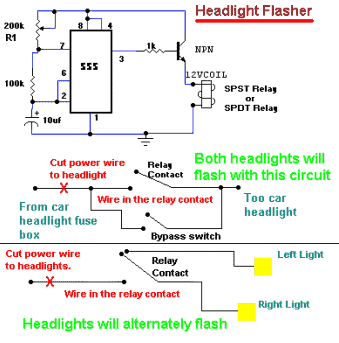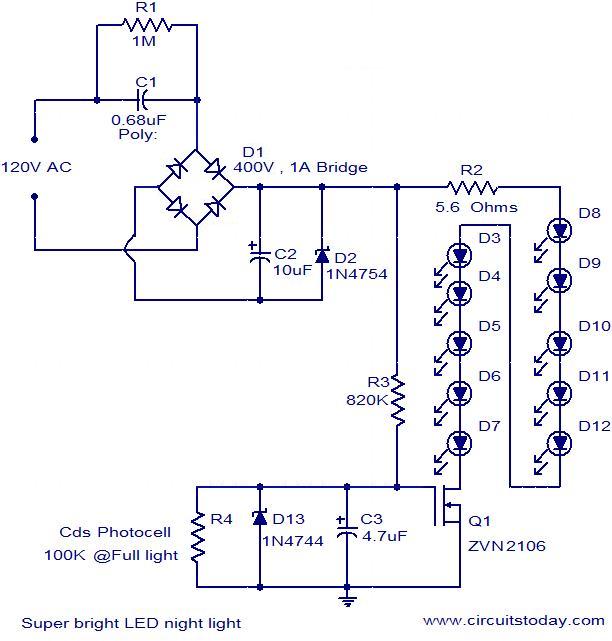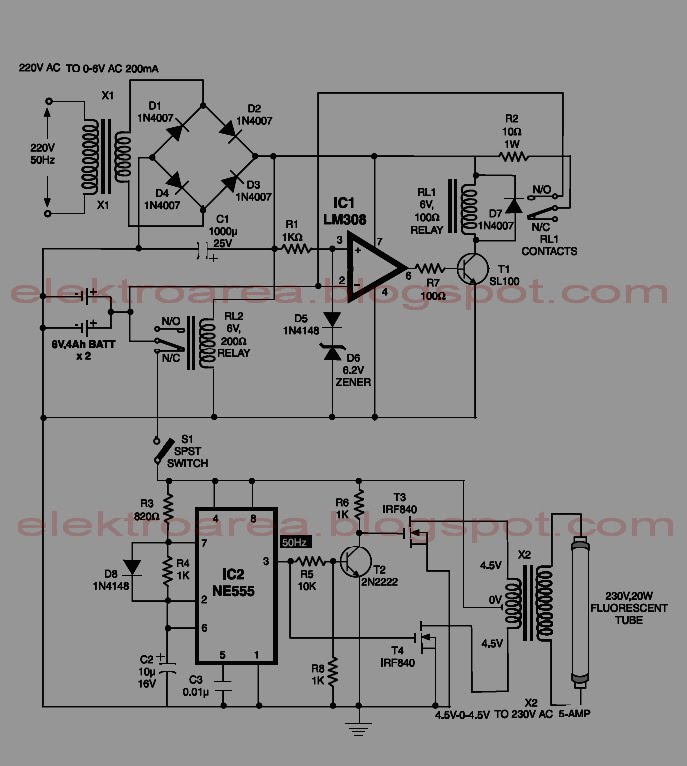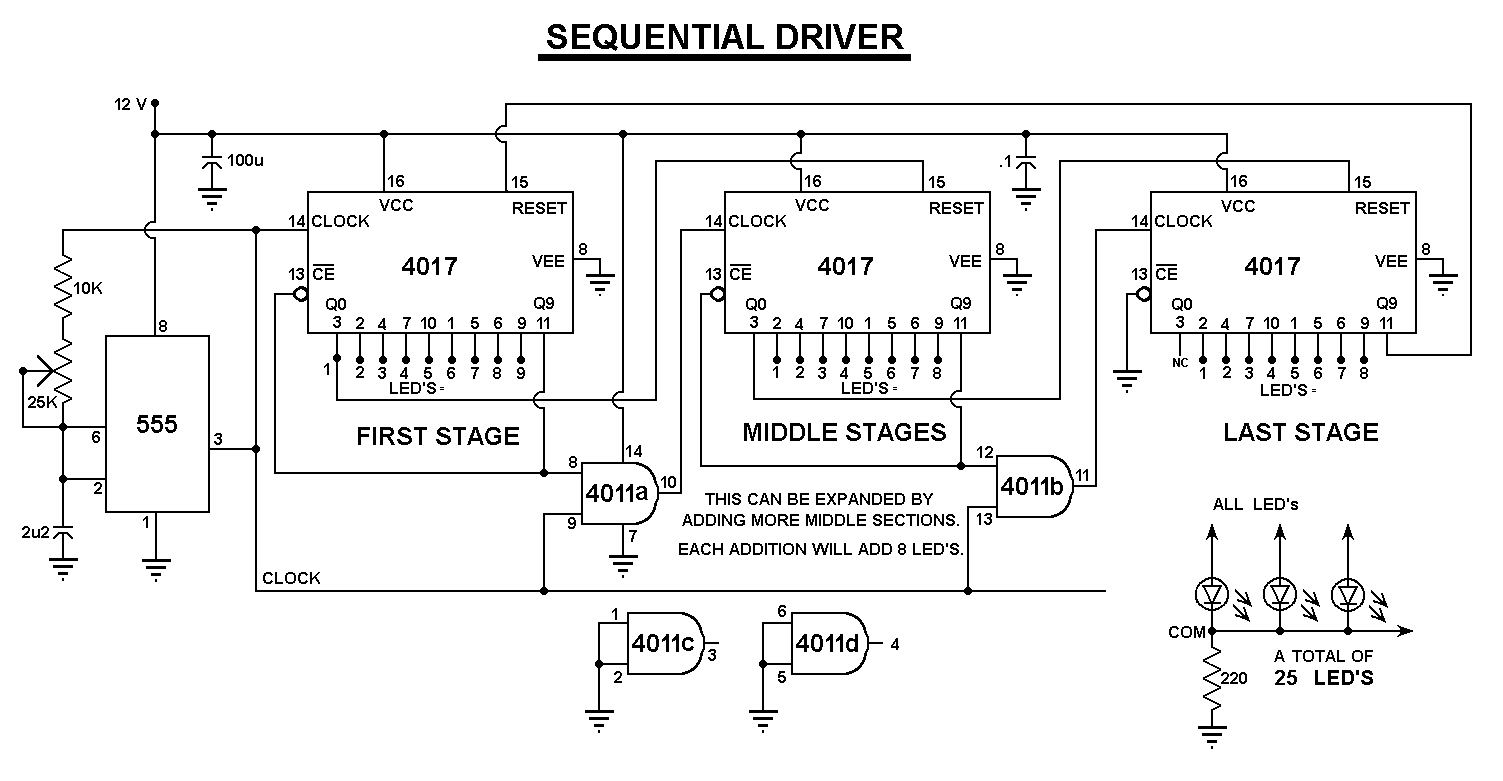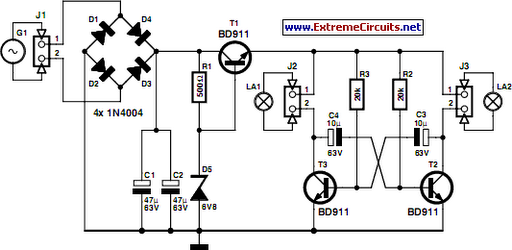
Descrete Multistage Light Sequencer
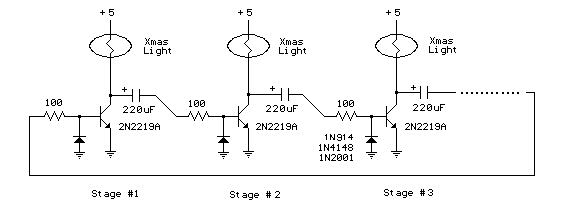
The drawing below illustrates a multistage light sequencer using discrete components and no integrated circuits. The concept is not new; a similar circuit was developed approximately 40 years ago using germanium transistors. The design connects the lights so that as one turns off, it triggers the next light to turn on, and so forth. This sequence is achieved through the use of a large capacitor between each stage, which charges when a stage turns off and supplies base current to the next transistor, thereby activating it. The circuit can accommodate any number of stages, and the drawing below depicts three small Christmas lights operating at around 5 volts and 200mA. The circuit may require manual initiation upon power application. To start the sequence, a momentary short can be connected across any one of the capacitors, which is then removed. A manual push button can be utilized for this purpose. If the circuit does not initiate when power is applied, with all lights off and all three capacitors charged to approximately 5 volts, a jumper can be connected across the 220uF capacitor on the left. This action discharges the capacitor and activates the second stage transistor and its corresponding light. Once the jumper is removed, the capacitor will begin charging through the base of the stage 2 transistor and the stage 1 light. This process maintains the second stage transistor in the on state while the capacitor continues to charge. Concurrently, the capacitor linking stages 2 and 3 discharges through a 100-ohm resistor and diode, as well as the stage 2 transistor. When the charging current of the capacitor drops below the threshold required to keep the stage 2 transistor active, the transistor and light will turn off, resulting in an increase in voltage at the collector of the stage 2 transistor to 5 volts. As the capacitor connecting stages 2 and 3 has discharged and the voltage at the collector of stage 2 rises, the capacitor from stage 2 to stage 3 will charge, activating the third stage, and the cycle continues for subsequent stages 4, 5, 6, 7, and back to 1. The rate of the sequence is determined by the capacitor and resistor values (220uF and 100 ohms in this instance), the load current (200mA), and the current gain of the specific transistor utilized. This arrangement operates at approximately 120 complete cycles per minute for three lights, which equates to about 167 milliseconds per light. Faster or slower rates can be achieved by modifying the capacitor values.
The multistage light sequencer circuit is designed with simplicity and effectiveness in mind, utilizing discrete components to create a visually appealing light sequence. Each stage of the sequencer consists of a transistor, which acts as a switch for the corresponding light. The use of capacitors between stages is crucial, as they store charge and contribute to the timing of the light sequence. The charging and discharging behavior of these capacitors is key to the operation of the circuit.
In the initial state, when the circuit is powered, all capacitors are charged, and no lights are illuminated. The manual initiation process allows for the first stage to be activated, setting off the cascading effect of lights turning on and off. The design can be modified to include additional stages by adding more transistors and capacitors, which would allow for a longer sequence of lights.
The choice of component values, particularly the capacitors and resistors, plays a significant role in determining the timing of the sequencer. By adjusting these values, the rate at which the lights turn on and off can be fine-tuned to achieve the desired effect. The current gain of the transistors also impacts the performance of the circuit, as it determines how effectively each transistor can switch the load current for the lights.
This circuit can be employed in various applications, including decorative lighting, signaling, or as a teaching tool for understanding basic electronic principles. The absence of integrated circuits makes it an excellent project for those interested in learning about discrete component circuitry and the fundamentals of transistor operation.The drawing below illustrates a multistage light sequencer using descrete parts and no integrated circuits. The idea is not new and I hear a similar circuit was developed about 40 years ago using germanium transistors.
The idea is to connect the lights so that as one turns off it causes the next to turn on, and so forth. This is accomplished with a large capacitor between each stage that charges when a stage turns off and supplies base current to the next transistor, thus turning it on. Any number of stages can be used and the drawing below illustrates 3 small Christmas lights running at about 5 volts and 200mA.
The circuit may need to be manually started when power is applied. To start it, connect a momentary short across any one of the capacitors and then remove the short. You could use a manual push button to do this. Assume the circuit doesnt start when power is applied amd all lights are off and all three capacitors are charged to about 5 volts. We connect a jumper across the 220uF capacitor on the left which discharges the capacitor and turns on the 2nd stage transistor and corresponding light.
When the jumper is removed, the capacitor will start charging through the base of the stage 2 transistor and stage 1 light. This causes the stage 2 transistor to remain on while the capacitor continues to charge. At the same time, the capacitor connecting stage 2 and 3 will discharge through the 100 ohm resistor and diode and stage 2 transistor.
When the capacitor charging current falls below what is needed to keep stage 2 turned on, the transistor and light will turn off causing the voltage at the collector of the stage 2 transistor to rise to 5 volts. Since the capacitor connecting stage 2 and 3 has discharged and the voltage rises at the collector of stage 2, the capacitor from stage 2 and 3 will charge causing the 3rd stage to turn on and the cycle repeats for sucessive stages 4, 5, 6, 7.
and back to 1. The sequence rate is determined by the capacitor and resistor values (220uF and 100 ohms in this case), load current (200mA in this case), and current gain of the particular transistor used. This arrangement runs at about 120 complete cycles per minute for 3 lights, or about 167mS per light.
Faster or slower rates can be obtained with different capacitor values. 🔗 External reference
The multistage light sequencer circuit is designed with simplicity and effectiveness in mind, utilizing discrete components to create a visually appealing light sequence. Each stage of the sequencer consists of a transistor, which acts as a switch for the corresponding light. The use of capacitors between stages is crucial, as they store charge and contribute to the timing of the light sequence. The charging and discharging behavior of these capacitors is key to the operation of the circuit.
In the initial state, when the circuit is powered, all capacitors are charged, and no lights are illuminated. The manual initiation process allows for the first stage to be activated, setting off the cascading effect of lights turning on and off. The design can be modified to include additional stages by adding more transistors and capacitors, which would allow for a longer sequence of lights.
The choice of component values, particularly the capacitors and resistors, plays a significant role in determining the timing of the sequencer. By adjusting these values, the rate at which the lights turn on and off can be fine-tuned to achieve the desired effect. The current gain of the transistors also impacts the performance of the circuit, as it determines how effectively each transistor can switch the load current for the lights.
This circuit can be employed in various applications, including decorative lighting, signaling, or as a teaching tool for understanding basic electronic principles. The absence of integrated circuits makes it an excellent project for those interested in learning about discrete component circuitry and the fundamentals of transistor operation.The drawing below illustrates a multistage light sequencer using descrete parts and no integrated circuits. The idea is not new and I hear a similar circuit was developed about 40 years ago using germanium transistors.
The idea is to connect the lights so that as one turns off it causes the next to turn on, and so forth. This is accomplished with a large capacitor between each stage that charges when a stage turns off and supplies base current to the next transistor, thus turning it on. Any number of stages can be used and the drawing below illustrates 3 small Christmas lights running at about 5 volts and 200mA.
The circuit may need to be manually started when power is applied. To start it, connect a momentary short across any one of the capacitors and then remove the short. You could use a manual push button to do this. Assume the circuit doesnt start when power is applied amd all lights are off and all three capacitors are charged to about 5 volts. We connect a jumper across the 220uF capacitor on the left which discharges the capacitor and turns on the 2nd stage transistor and corresponding light.
When the jumper is removed, the capacitor will start charging through the base of the stage 2 transistor and stage 1 light. This causes the stage 2 transistor to remain on while the capacitor continues to charge. At the same time, the capacitor connecting stage 2 and 3 will discharge through the 100 ohm resistor and diode and stage 2 transistor.
When the capacitor charging current falls below what is needed to keep stage 2 turned on, the transistor and light will turn off causing the voltage at the collector of the stage 2 transistor to rise to 5 volts. Since the capacitor connecting stage 2 and 3 has discharged and the voltage rises at the collector of stage 2, the capacitor from stage 2 and 3 will charge causing the 3rd stage to turn on and the cycle repeats for sucessive stages 4, 5, 6, 7.
and back to 1. The sequence rate is determined by the capacitor and resistor values (220uF and 100 ohms in this case), load current (200mA in this case), and current gain of the particular transistor used. This arrangement runs at about 120 complete cycles per minute for 3 lights, or about 167mS per light.
Faster or slower rates can be obtained with different capacitor values. 🔗 External reference
Warning: include(partials/cookie-banner.php): Failed to open stream: Permission denied in /var/www/html/nextgr/view-circuit.php on line 713
Warning: include(): Failed opening 'partials/cookie-banner.php' for inclusion (include_path='.:/usr/share/php') in /var/www/html/nextgr/view-circuit.php on line 713
